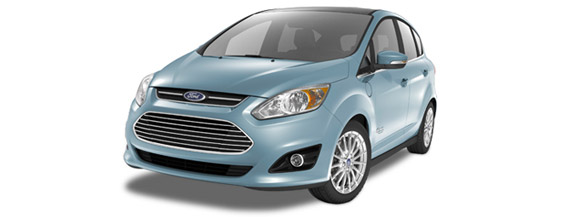Sustainability Report 2013/14
Climate Change and the Environment
Plug-in Hybrid Electric Vehicles (PHEVs)

Ford C‑MAX Energi
Plug-in hybrid electric vehicles are powered by an internal combustion engine and a high-voltage electric battery that can be charged from an electric outlet. The engine and the battery work together to provide the benefits of grid-connected power and hybrid powertrain efficiency. Ford offers two PHEVs in the U.S., the C‑MAX Energi and the Fusion Energi.
Technology Overview
PHEVs are similar to HEVs in that they are equipped with both an electric battery and a gas-powered engine. Unlike HEVs, however, PHEVs are equipped with a high-capacity battery that can be charged from a private household or public electric outlet. While regular HEVs maintain a roughly constant battery charge, PHEVs discharge the battery while driving to provide additional fuel savings. PHEVs have the potential to reduce tailpipe emissions to near zero when running on battery power. When the battery is depleted, the vehicle can continue to operate on the gas-powered engine, providing significant benefits over battery electric vehicles in terms of driving range before refueling. A PHEV’s overall life cycle emissions depend on the electrical power source and the usage characteristics of the vehicle. PHEVs can be significantly less expensive for consumers to operate than gasoline-powered vehicles, particularly for consumers who take relatively short trips most of the time. During such trips, PHEVs allow drivers to travel on grid-based electricity stored in batteries instead of more costly gasoline.
The high-voltage battery is charged through regenerative braking and discharged during acceleration events to improve the overall fuel economy of the vehicle – similar to the operation of today’s conventional hybrids.
Benefits
Overall, plug-in hybrid vehicles offer several benefits, including:
- Reduced dependency on petroleum and increased energy independence,
- Reduced environmental impact through reductions in greenhouse gas emissions as well as smog-forming tailpipe emissions,
- Increased use of electricity from renewable energy sources (e.g., wind and solar) for vehicle recharging, and
- Potential consumer savings on energy and fuel costs.
PHEV vehicles provide the extra benefit of being able to charge the batteries at home or other parking location. This means that PHEVs might better suit those customers who do the majority of their driving in city and other urban environments, where electric battery power is the preferred powertrain alternative.
Deployment
Ford currently offers two PHEVs in the U.S.: the Ford C‑MAX Energi and the Fusion Energi. We plan to introduce the C‑MAX Energi in Europe in 2014.
Like Ford’s HEVs, the C‑MAX Energi and Fusion Energi offer a range of information-technology tools to help drivers improve fuel efficiency. For more information on these technologies, please see Living the Electric Lifestyle.
The long-term success of PHEVs in the real world depends on cooperation between automakers, utilities, the government and drivers. Ford is engaged in multiple collaborative projects to help smooth the transition to electrified vehicles. For more information on this, please see Improving the Electric Vehicle Ecosystem in our Electrification section.
© 2014 Ford Motor Company